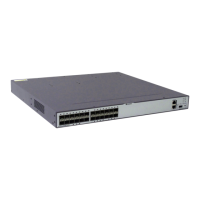NOTE
l When the LS age field value (aging time) in the header of an LSA reaches 3600s, the LSA is deleted.
l If an ASBR also functions as an ABR, flush-waiting-timer does not take effect. This prevents
Type 5 LSAs in the non-NSSAs from being deleted.
l If an ASBR also functions as an ABR, set the parameter no-import-route to prevent external
routes imported using the import-route command from being advertised to the NSSA.
l To reduce the number of LSAs that are transmitted to the NSSA, set the parameter no-
summary on an ABR. This prevents the ABR from transmitting Type 3 LSAs to the NSSA.
l After the parameter set-n-bit is configured, the switch re-establishes neighbor relationships
with the neighboring switches in the NSSA.
l If multiple ABRs are deployed in the NSSA, the system automatically selects an ABR
(generally the switch with the largest router ID) as a translator to translate Type 7 LSAs into
Type 5 LSAs. You can also configure the parameter translator-always on an ABR to specify
the ABR as an all-the-time translator. To specify two ABRs for load balancing, configure
the parameter translator-always on two ABRs to specify the ABRs as all-the-time
translators. This prevents LSA flooding caused by translator role changes.
l The parameter translator-interval is used to ensure uninterrupted services when translator
roles change. The interval-value value must be greater than the flooding period.
Step 5 (Optional)Run:
default-cost cost
The cost of the default route to the NSSA is set.
To ensure the reachability of AS external routes, the ABR in the NSSA generates a default route
and advertises the route to the other switches in the NSSA.
Type 7 LSAs can be used to carry default route information to guide traffic to other ASs.
Multiple ABRs may be deployed in an NSSA. To prevent routing loops, ABRs do not calculate
the default routes advertised by each other.
By default, the cost of the default route to the NSSA is 1.
----End
Checking the Configuration
Run either of the following commands to check LSDB information.
l display ospf [ process-id ] lsdb [ brief ]
l display ospf [ process-id ] lsdb [ router | network | summary | asbr | ase | nssa | opaque-
link | opaque-area | opaque-as ] [ link-state-id ] [ originate-router [ advertising-router-
id ] | self-originate ]
Run either of the following commands to check routing table information.
l display ospf [ process-id ] routing [ ip-address [ mask | mask-length ] ] [ interface
interface-type interface-number ] [ nexthop nexthop-address ]
l display ospf [ process-id ] routing router-id [ router-id ]
Run the display ospf [ process-id ] interface [ all | interface-type interface-number ]
[ verbose ] command to check OSPF interface information.
S6700 Series Ethernet Switches
Configuration Guide - IP Routing 4 OSPF Configuration
Issue 01 (2012-03-15) Huawei Proprietary and Confidential
Copyright © Huawei Technologies Co., Ltd.
120

